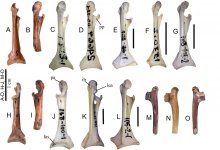Fred Ruhe
Well-known member

Nikita V. Zelenkov & Soraida F. González, 2021
A new extinct species of Margarobyas (Strigiformes) and the evolutionary history of the endemic Cuban bare-legged owl (M. lawrencii)
Journal of Vertebrate Paleontology in press
e1995869. doi:10.1080/02724634.2021.1995869
ABSTRACT
The Cuban bare-legged owl (Margarobyas lawrencii) is a poorly studied bird of uncertain affinities within Strigidae (true owls). Molecular data indicate that M. lawrencii may be one of the earliest diverging lineages of crown group Strigidae, but the evolutionary history of this taxon remains obscure. Here we describe a fossil species of Margarobyas from the Upper Pleistocene of Western Cuba and for the first time address the comparative osteology of this genus. The osteological survey confirms the remarkable morphological distinctiveness of the modern Margarobyas lawrencii. Margarobyas displays a derived similarity to Ninox owls (hawk-owls, subfamily Ieraglaucinae) in the morphology of the quadratum, but in the overall morphology of the skeleton it is also similar to members of the subfamily Striginae and species of Megascops (screech owls) in particular. The mixture of characters of both Striginae and Ieraglaucinae implies an early (no later than Oligocene) divergence of Margarobyas, thus supporting a long evolutionary history of these owls compared with other endemic owl species of the West Indies. The antiquity of Margarobyas makes it, along with Todidae (todies), one of the most archaic components of the modern West Indian avifauna.
The paper describes Margarobyas abronensis sp. nov.
Enjoy,
Fred
A new extinct species of Margarobyas (Strigiformes) and the evolutionary history of the endemic Cuban bare-legged owl (M. lawrencii)
Journal of Vertebrate Paleontology in press
e1995869. doi:10.1080/02724634.2021.1995869
ABSTRACT
The Cuban bare-legged owl (Margarobyas lawrencii) is a poorly studied bird of uncertain affinities within Strigidae (true owls). Molecular data indicate that M. lawrencii may be one of the earliest diverging lineages of crown group Strigidae, but the evolutionary history of this taxon remains obscure. Here we describe a fossil species of Margarobyas from the Upper Pleistocene of Western Cuba and for the first time address the comparative osteology of this genus. The osteological survey confirms the remarkable morphological distinctiveness of the modern Margarobyas lawrencii. Margarobyas displays a derived similarity to Ninox owls (hawk-owls, subfamily Ieraglaucinae) in the morphology of the quadratum, but in the overall morphology of the skeleton it is also similar to members of the subfamily Striginae and species of Megascops (screech owls) in particular. The mixture of characters of both Striginae and Ieraglaucinae implies an early (no later than Oligocene) divergence of Margarobyas, thus supporting a long evolutionary history of these owls compared with other endemic owl species of the West Indies. The antiquity of Margarobyas makes it, along with Todidae (todies), one of the most archaic components of the modern West Indian avifauna.
The paper describes Margarobyas abronensis sp. nov.
Enjoy,
Fred





